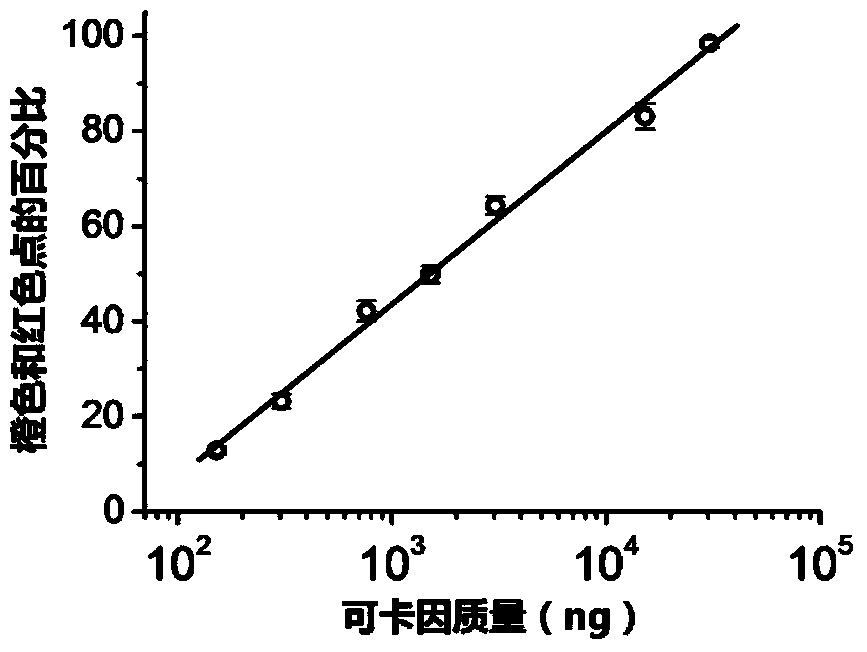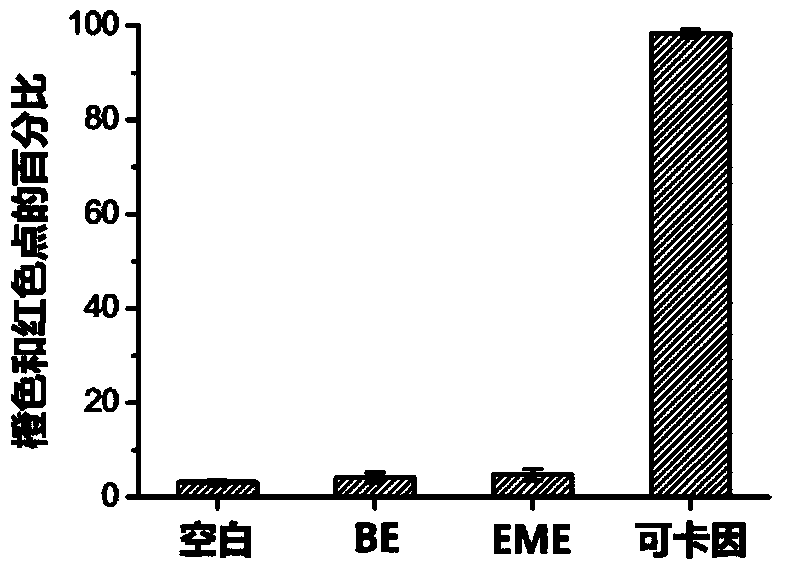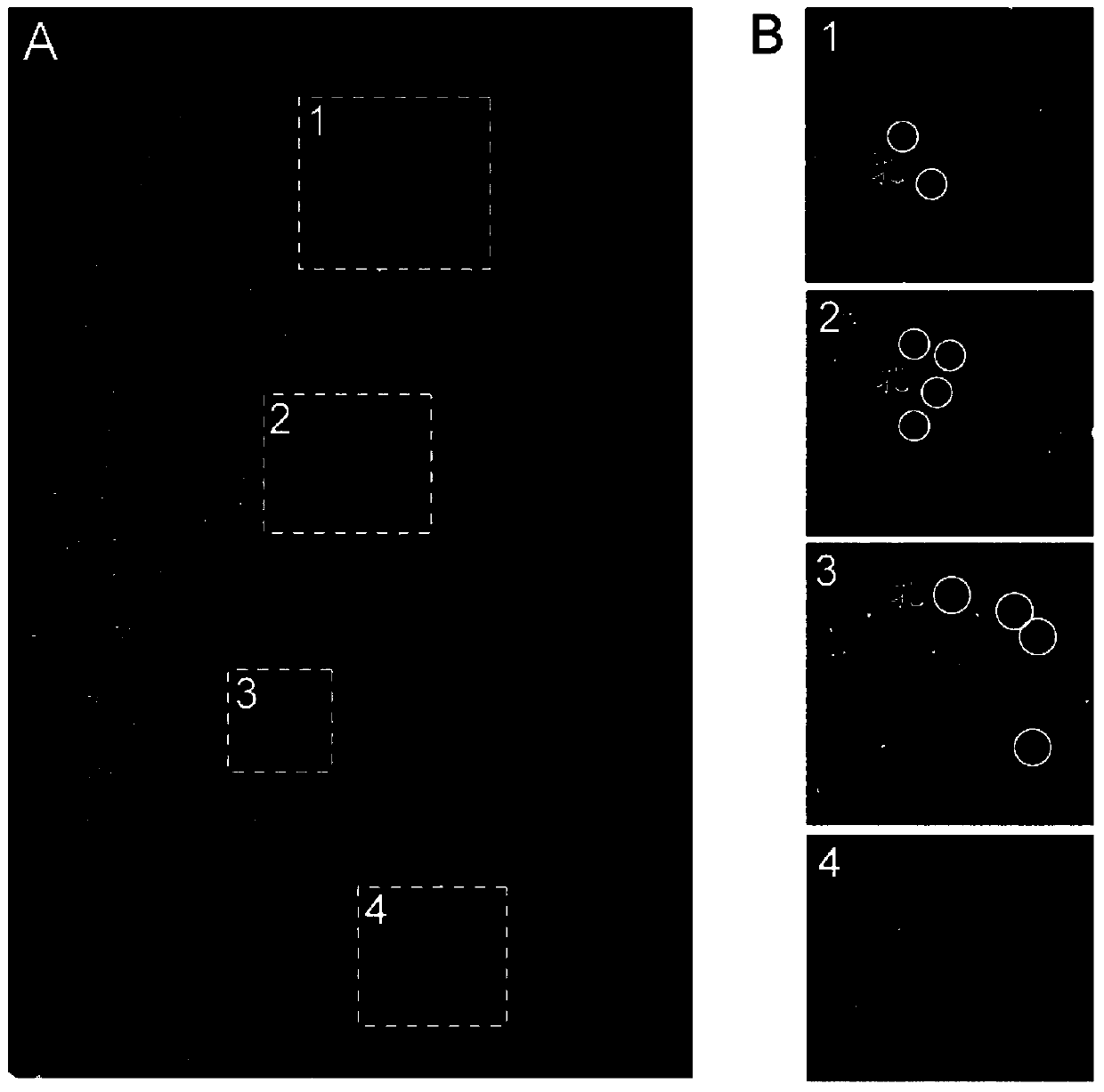Method for conducting fingerprint identification and analyzed object detection simultaneously through dark-field microscope
A dark field microscope and fingerprint recognition technology, applied in the fields of analyzing materials, measuring devices, human identification, etc., can solve problems such as unreported, complex and expensive large-scale instruments, and inability to achieve non-destructive analysis, and achieve the effect of easy standardization
- Summary
- Abstract
- Description
- Claims
- Application Information
AI Technical Summary
Problems solved by technology
Method used
Image
Examples
Embodiment 1
[0028] Example 1: Aptamer-based Nanoplasmonic Probes Imaging Latent Fingerprints on Microscope Slides Under Dark Field Microscopy and Simultaneously Detecting Cocaine Carried in Fingerprints
[0029] (1) Preparation of nanoplasmonic probes: 150 mL trisodium citrate aqueous solution (2.2 mM) was heated to boiling for 15 min, and 1 mL chloroauric acid aqueous solution (25 mM) was added to react for 15 min. Cool down to 95°C, add 1mL chloroauric acid aqueous solution (25mM) to react for 30min, repeat twice. Then take out 55mL sample, and add 53mL water and 2mL trisodium citrate aqueous solution (60mM). Repeat the step of adding 1mL chloroauric acid aqueous solution (25mM) for reaction growth 6 times to obtain spherical gold nanoparticles Au NPs with a diameter of 50nm (this method can also prepare spherical gold nanoparticles with a diameter of 40-60nm, just change the last step to add 1 mL of chloroauric acid aqueous solution (25 mM) for the number of repetitions of the growth ...
Embodiment 2
[0036] Example 2: Aptamer-based nanoplasmonic probes image latent fingerprints on microscope slides under a dark-field microscope and simultaneously detect cocaine carried in the fingerprints
[0037] (1) Preparation of nanoplasmonic probes: Add chloroauric acid to 10 mL of cetyltrimethylammonium chloride aqueous solution (0.1 M) to a concentration of 0.25 mM. Add 0.45 mL of sodium borohydride aqueous solution (20 mM) and react at 30 °C for 1 hour as a seed solution. Prepare two bottles of growth solution: Add 320mg cetyltrimethylammonium chloride to 9.605mL deionized water, add 0.25mL chloroauric acid aqueous solution (10mM), 0.01mL sodium bromide aqueous solution (10mM), 0.09mL ascorbic acid Aqueous solution (40mM). React for 30min, repeat twice. Then take out 55mL sample, and add 53mL water and 2mL trisodium citrate aqueous solution (60mM). Add 0.45mL of the above seed solution to a bottle of growth solution and shake for 5 seconds, then take out 0.45mL and transfer it t...
Embodiment 3
[0041] Example 3: The nano-plasmonic probe based on the nucleic acid aptamer images the latent fingerprint on the microscope slide under a dark-field microscope and simultaneously detects the adenosine triphosphate carried in the fingerprint
[0042](1) Preparation of nanoplasmonic probes: 150 mL trisodium citrate aqueous solution (2.2 mM) was heated to boiling for 15 min, and 1 mL chloroauric acid aqueous solution (25 mM) was added to react for 15 min. Cool down to 95°C, add 1mL chloroauric acid aqueous solution (25mM) to react for 30min, repeat twice. Then take out 55mL sample, and add 53mL water and 2mL trisodium citrate aqueous solution (60mM). Repeat the step of adding 1mL chloroauric acid aqueous solution (25mM) for reaction growth 6 times to obtain spherical gold nanoparticles (Au NPs) with a diameter of 50nm (this method can also prepare spherical gold nanoparticles with a diameter of 40-60nm, just change the last Add 1 mL of chloroauric acid aqueous solution (25 mM) ...
PUM
| Property | Measurement | Unit |
|---|---|---|
| Diameter | aaaaa | aaaaa |
| Side length | aaaaa | aaaaa |
| Diameter | aaaaa | aaaaa |
Abstract
Description
Claims
Application Information
 Login to View More
Login to View More - Generate Ideas
- Intellectual Property
- Life Sciences
- Materials
- Tech Scout
- Unparalleled Data Quality
- Higher Quality Content
- 60% Fewer Hallucinations
Browse by: Latest US Patents, China's latest patents, Technical Efficacy Thesaurus, Application Domain, Technology Topic, Popular Technical Reports.
© 2025 PatSnap. All rights reserved.Legal|Privacy policy|Modern Slavery Act Transparency Statement|Sitemap|About US| Contact US: help@patsnap.com



